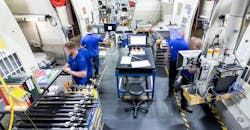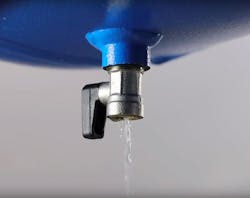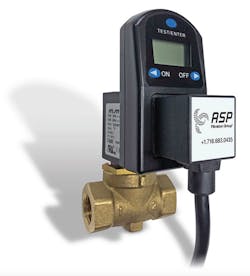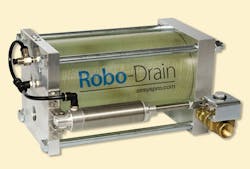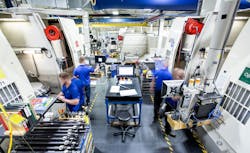Understanding the important role of the condensate drain is part of a larger equation. Ideally, a drain removes condensed moisture from a compressed air without letting compressed air escape. The drain is one of many variables and can help with substantially reduce operating costs. The drain must be the best choice for the system, installed properly, and rated for a specific system, otherwise it will not be able to do properly remove condensate, allow costly compressed air to leak, or both.
Condensate shortens the lifespan of a compressed air system, resulting in reduced productivity and increased maintenance costs. One thing is guaranteed: when compressed air is produced, so is condensate. Because the outside air contains moisture, condensate (the liquid formed by compressing the ambient moisture) is an inevitable byproduct that can build up in the compressed air system. This free water can shorten the life of the compressed air components by washing away lubricants. Some of the lubricating oil also migrates into the condensate along with scale, corrosion, and metal particles, which result in substantial maintenance costs, operational downtime, and loss of productivity. A condensate drain removes free water to protect the compressed air system. Without a properly operating drain, contaminants are guaranteed to collect in the system and cause havoc.
About the only thing worse than having to manually drain condensate from a compressed-air system is doing nothing. Fortunately, several automated options are available to remove moisture.
Different Drains for Different Situations
A variety of condensate drains is available to handle the many variables associated with compressed air systems, such as different configurations, capabilities, ages, and workload. Due to the direct impact on a system including the operational costs, choosing the right drain for a particular application is important.
Proper drain sizing and selection helps minimize the loss of compressed air, which can add substantially to a plant’s electrical consumption. Proper drain sizing and selection helps minimize the loss of compressed air, which can add substantially to a plant’s electrical consumption. Click here to download a PDF on the cost of lost compressed air.) Drains can be installed on an intercooler, aftercooler, filter, dryer, receiver, or drip leg, or at the point of use.
Although many designs are available, automatic drains fall into two primary categories: timer drains and demand drains. Timer drains are set to discharge condensate at predetermined intervals. Demand drains (sometimes called no-loss or zero-loss drains) collect condensate until their reservoir is full, then discharge the water.
A third type is a pneumatically driven drain. These are most often used in compressed air systems with no access to electrical power, such as mobile equipment.
Selecting the wrong type of drain can result in wasted air, increased demand on employees to maintain malfunctioning equipment, and higher operating costs. Consider the following variables to ensure a fully optimized and cost-effective system.
Ambient conditions and compressor size determine the amount of condensate generated. More condensate will require additional capacity on the drain output. Seasonal variations of the ambient environment cause temperature and humidity fluctuations in the ambient air, and these fluctuations need to be considered when selecting a condensate drain. For example, if the compressor operates in a non-air conditioned facility, ambient air generally will be more humid in the summer than in the winter. Even the most temperate climate will undergo significant variations in temperature and humidity that affect the volume of condensate. Fortunately, many manufacturers offer tools to assist in selecting the appropriately sized drain for your application.
The amount of contamination can be a challenge to predict, yet most operators have a good idea of whether their systems have a low or heavy level of contamination. A drain overwhelmed by the amount of contamination in the air and condensate usually results in clogging, which can cause compressed air to continually leak from the drain. Not understanding a drain’s capacity to effectively handle contaminants can be extremely costly by wasting compressed air.
System pressure also influences the type of drain design selected. The drain may not operate as designed if system pressure is too high or too low. Some drains require specialty systems to accommodate vacuum applications. Although most pneumatic systems operate at a positive pressure, those operating under vacuum require special features to control condensate. Air System Products offers demand drains designed specifically for such applications.
A full understanding of your operating conditions is essential. In addition to the ambient air, some environments are exposed to heavily corrosive elements that can damage standard materials. When operating in highly corrosive environments, stainless steel components should be specified.
Timer Drains: A Cut Above Basic
The most basic way to remove condensate is to use a manual valve that periodically needs to be opened, perhaps once a day. This demands regular attention by a worker to manually open the valve. This can be burden even for a small shop, a good candidate for timer drains.
Relatively inexpensive and easy to install, timer-operated drains can be reliable, cost-effective solutions in certain situations. Due to their low price, timer drains are appropriate for small operations where the amount of condensate is low and the investment of a more-costly demand drain may not be justified. However, timer drains cannot detect how much condensate has collected. They can open too frequently or not frequently enough, which can waste air or allow condensate to build up.
A timer drain is the appropriate choice when:
• the operating system has a small capacity, less than 25 scfm,
• the cost of a higher-performing drain is prohibitive
• consistent, preventive maintenance and servicing is not an obstacle,
• the ambient environment is not corrosive, and
• the system is free from scale and corrosion.
As convenient and inexpensive as timer drains can seem, though, they are unable to adjust to varying operating conditions and cannot effectively manage surges of condensate. These drains come with adjustable discharge timing options. Preventive maintenance includes pressing a test button to check operation, making sure the drain is not clogged, and (depending on the design) cleaning the drain’s inlet strainer. Having to repeatedly adjust timer drains is another drawback. If drains interval and duration are set for worst-case conditions, excessive compressed air loss results when the drain opens more frequently and for longer periods than needed.
Demand Drains Offer Intelligence
Intelligent by design, demand (zero-loss) drains filter collected condensate without exhausting compressed air and automatically monitor ambient conditions and system fluctuations. Demand drains discharge condensate on demand, and so they adjust to fluctuations in ambient conditions. In extremely cold weather, some types of demand drains require an optional heating element to prevent freezing.
Demand drains have become increasingly popular not only for their precise functionality, but also for their high energy efficiency. Increased efforts to eliminate wasted air and create more energy-efficient systems has led plant managers to recognize the improved energy savings of these reliable drain options. The initial cost of a demand drain will exceed that of a timer or manual drain but, in most cases, will pay for itself within a year of purchase or sooner.
A demand drain may be the best choice if:
• ambient conditions and the size of the compressor generate substantial condensate,
• the requirement for high air quality is essential,
• maintenance resources are limited,
• a facility’s compressed air loss (especially from leaks) is substantial, and
• improving total cost of operation is a high priority
Because demand drains actively control the amount of condensate, they are more effective than timer drains. Some fully automatic demand drains have a translucent reservoir to allow visual assurance of functionality. This translucent vessel allows personnel to monitor the amount of condensate in the drain.
The variety of demand drains includes those powered by electricity or compressed air (often referred to as pneumatic drains). Some designs require no additional input to operate, and each has its own set pros and cons. But regardless of their design, demand drains prevent compressed air from escaping when condensate is being drained.
Bill Niblock is business unit leader & vice president, operations at Air System Products LLC, part of the Filtration Group, and is located in Lancaster, N.Y. for more information, call (716) 683 0435 or click here.
Sidebar 1: Two Biggies: Location and Installation
Condensate drains may be needed at more than one location in a compressed air system. The amount of condensate may vary from different types of components, such compressors, receivers, and dryers. This moisture must be removed from all locations.
Avoid trapped condensate—The drain needs to be installed below the source of condensate. This ensures that the condensate does not collect and pool in unwanted locations. If you are attaching the drain to a drip leg, be sure the drip legs are properly sized.
Avoid air locking—Undersized piping can cause the drain line to become blocked, known as air locking. A properly sized balance line will prevent this from happening.
A single drain on multiple drain points—It may be tempting to run two or more drain points to one drain. However, it is likely that different pressures exist at these points. Air and condensate will take the path of least resistance, so multiple drain points may bypass one or more operations, resulting in condensate downstream and potential failure.
Headroom for connections— You must allocate space for the drain to be installed and connected. Top, side, and bottom inlets are available on some drains so you must consider the orientation of your drain installation.
Sidebar 2: Drain Selector Checklist
Compressor Size (cfm or hp)
- The larger the compressor the more condensate you can expect
Compressor volume
- Location: Depending on the location of the drain, the amount of condensate varies. Aftercoolers and air receivers typically generate more condensate than a dryer or drip leg.
- Environment: The volume of condensate produced depends on
• Ambient Temperature: Hot air has a higher moisture content. When the area is compressed, the moisture is compressed into water vapor (condensate)
• Relative Humidity: A higher relative humidity contains more moisture and will yield more condensate.
Operating Pressure
- Drains are typically designed with a maximum operating pressure of 200-250 psi. Some systems require drains that are designed for higher pressures.
Levels off Contamination and Valve Design
- The amount of contamination resent in the condensate will impact the operation of a drain. A straight through valve design is often recommended to handle a variety of contaminants.
Hazardous and/or Corrosive Environments
- The environment where the drain is positioned may dictate the need for a robust material or construction. In corrosive or hazardous environments, a stainless steel drain and/or a NEMA-rated housing may be required.
Vacuum Systems
- Vacuum systems operate at a negative pressure and require a unique design. This design ensures the drain reservoir is isolated so the condensate is expelled and not pulled into the vacuum system.
Availability of the Appropriate Utility to Operate the Drain (Electric or Pneumatic)
- Most timer drains operate with electricity and require a power outlet. For zero loss drains, there are fully pneumatic options available that either use system pressure (i.e. internally operated pneumatic drain) or control air (i.e. eternally operated pneumatic drain) to open the valve.
Proper Size and Type of Connection
- The connection size and type must match the drain point. Careful attention must be paid to ensure the volume of condensate passes without restriction.
Visual Check or Alarm
- A translucent housing or alarm system may be necessary for a visual indication that the drain is functioning properly.
Special Vendor Considerations
- Customer support, warranties, and local energy-consumption incentives can potentially save costs.
Sidebar 3: An Informed Choice
A Tier-2 automotive supplier in the midwest was using a standard timer drain on the dryer of a 100-hp compressed air system. The drain worked well throughout the winter months when the ambient humidity was low. However, during the humid summer months, problems from condensate arose. After consulting with their compressed air dealer, plant personnel learned that the timer drain was not staying open long enough to effectively evacuate the periodic increases in condensate.
Courtesy: Asheville Chamber of Commerce, www.ashevillechamber.org
They had two options: discharge for a longer period of time or consider transitioning to a demand drain.
Option 1: Opening the drain’s valve from 5 to 10 sec. every hour would eliminate the increased amount of condensate. If they chose this option, they calculated the total amount of lost compressed air over the year would cost $500.
Option 2: Upgrading their system by specifying and installing demand drain would have a total cost, including installation, of $350.
Decision: The automotive supplier invested in the demand drain, which completely eliminated the condensate and the problems associated with it. No additional maintenance was required, and the new drain paid for itself within in eight months.
About the Author
Bill Niblock
Business Unit Leader & Vice President, Operations
Bill Niblock is business unit leader & vice president, operations at Air System Products LLC, part of the Filtration Group, and is located in Lancaster, N.Y. for more information, call (716) 683 0435 or visit www.airsyspro.com.
